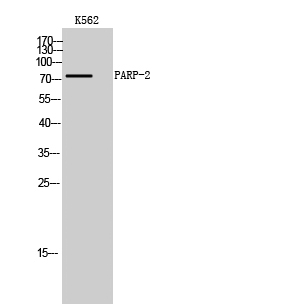PARP-2 Polyclonal Antibody
- Catalog No.:YT3594
- Applications:WB;ELISA
- Reactivity:Human;Mouse
- Target:
- PARP-2
- Fields:
- >>Base excision repair;>>Apoptosis
- Gene Name:
- PARP2
- Protein Name:
- Poly [ADP-ribose] polymerase 2
- Human Gene Id:
- 10038
- Human Swiss Prot No:
- Q9UGN5
- Mouse Gene Id:
- 11546
- Mouse Swiss Prot No:
- O88554
- Immunogen:
- The antiserum was produced against synthesized peptide derived from human PARP2. AA range:151-200
- Specificity:
- PARP-2 Polyclonal Antibody detects endogenous levels of PARP-2 protein.
- Formulation:
- Liquid in PBS containing 50% glycerol, 0.5% BSA and 0.02% sodium azide.
- Source:
- Polyclonal, Rabbit,IgG
- Dilution:
- WB 1:500 - 1:2000. ELISA: 1:40000. Not yet tested in other applications.
- Purification:
- The antibody was affinity-purified from rabbit antiserum by affinity-chromatography using epitope-specific immunogen.
- Concentration:
- 1 mg/ml
- Storage Stability:
- -15°C to -25°C/1 year(Do not lower than -25°C)
- Other Name:
- PARP2;ADPRT2;ADPRTL2;Poly [ADP-ribose] polymerase 2;PARP-2;hPARP-2;ADP-ribosyltransferase diphtheria toxin-like 2;ARTD2;NAD(+) ADP-ribosyltransferase 2;ADPRT-2;Poly[ADP-ribose] synthase 2;pADPRT-2
- Observed Band(KD):
- 75kD
- Background:
- This gene encodes poly(ADP-ribosyl)transferase-like 2 protein, which contains a catalytic domain and is capable of catalyzing a poly(ADP-ribosyl)ation reaction. This protein has a catalytic domain which is homologous to that of poly (ADP-ribosyl) transferase, but lacks an N-terminal DNA binding domain which activates the C-terminal catalytic domain of poly (ADP-ribosyl) transferase. The basic residues within the N-terminal region of this protein may bear potential DNA-binding properties, and may be involved in the nuclear and/or nucleolar targeting of the protein. Two alternatively spliced transcript variants encoding distinct isoforms have been found. [provided by RefSeq, Jul 2008],
- Function:
- catalytic activity:NAD(+) + (ADP-D-ribosyl)(n)-acceptor = nicotinamide + (ADP-D-ribosyl)(n+1)-acceptor.,function:Involved in the base excision repair (BER) pathway, by catalyzing the poly(ADP-ribosyl)ation of a limited number of acceptor proteins involved in chromatin architecture and in DNA metabolism. This modification follows DNA damages and appears as an obligatory step in a detection/signaling pathway leading to the reparation of DNA strand breaks.,PTM:Poly-ADP-ribosylated by PARP1.,similarity:Contains 1 PARP alpha-helical domain.,similarity:Contains 1 PARP catalytic domain.,subunit:Component of a base excision repair (BER) complex, containing at least XRCC1, PARP1, POLB and LIG3. Homo- and heterodimer with PARP1.,tissue specificity:Widely expressed, mainly in actively dividing tissues. The highest levels are in the brain, heart, pancreas, skeletal muscle and testis; also detected i
- Subcellular Location:
- Nucleus . Chromosome . Recruited to DNA damage sites. .
- Expression:
- Widely expressed, mainly in actively dividing tissues (PubMed:10364231). The highest levels are in the brain, heart, pancreas, skeletal muscle and testis; also detected in kidney, liver, lung, placenta, ovary and spleen; levels are low in leukocytes, colon, small intestine, prostate and thymus (PubMed:10364231).
- June 19-2018
- WESTERN IMMUNOBLOTTING PROTOCOL
- June 19-2018
- IMMUNOHISTOCHEMISTRY-PARAFFIN PROTOCOL
- June 19-2018
- IMMUNOFLUORESCENCE PROTOCOL
- September 08-2020
- FLOW-CYTOMEYRT-PROTOCOL
- May 20-2022
- Cell-Based ELISA│解您多样本WB检测之困扰
- July 13-2018
- CELL-BASED-ELISA-PROTOCOL-FOR-ACETYL-PROTEIN
- July 13-2018
- CELL-BASED-ELISA-PROTOCOL-FOR-PHOSPHO-PROTEIN
- July 13-2018
- Antibody-FAQs
- Products Images

- Western Blot analysis of K562 cells using PARP-2 Polyclonal Antibody cells nucleus extracted by Minute TM Cytoplasmic and Nuclear Fractionation kit (SC-003,Inventbiotech,MN,USA).



